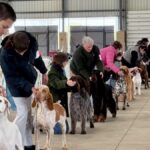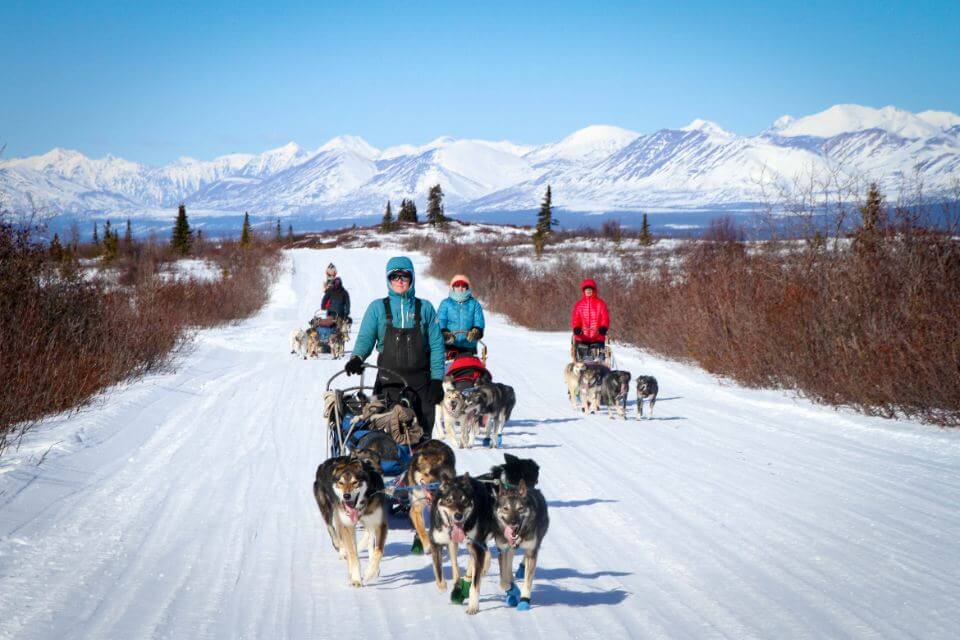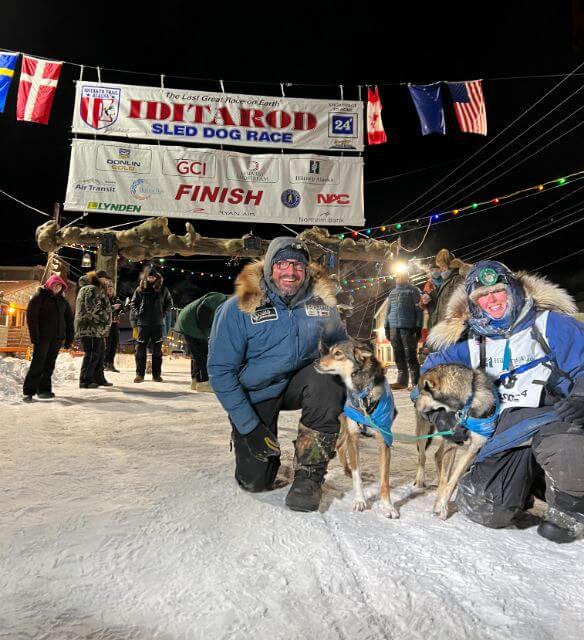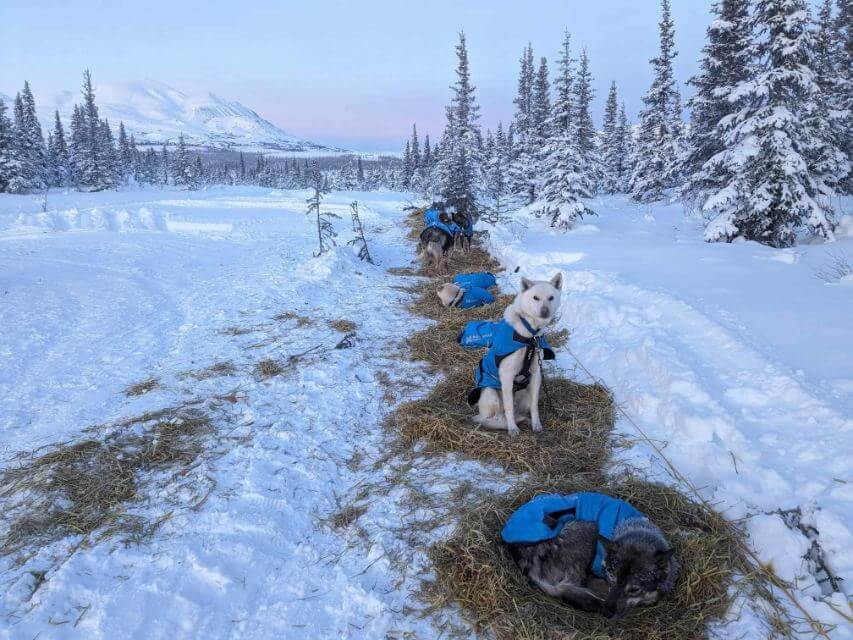


Home » A Day in the Life of a Sled Dog Musher

Squid Acres Kennel is a competitive sled dog racing kennel and tour company owned and operated by Paige Drobny and Cody Strathe, currently located in Cantwell, Alaska, near Denali National Park and at the Susitna Adventure Lodge on the scenic Denali Highway. The kennel is just one of many in the North that participates in sled dog racing and breeding, something that is relatively popular in the region.
We recently had the opportunity to catch up with Squid Acres to discuss a typical day in the life of a sled dog musher and what goes into it, a lifestyle that is probably a bit different than the tales from the “Balto” movie, Eight Below, and the way things are sometimes portrayed on TV. Here’s everything you need to know:

Cody Strathe: My wife, Paige Drobny, and I got into sled dogs in 2007 while living in Fairbanks, Alaska, for graduate school. We would go out skiing after class and it was common for folks to have small dog teams for recreation that would come past us on the trails. We thought that would be so much fun. I decided to build a dogsled for my wife for Christmas and she got three rescue dogs to add to our two pet dogs. We had our first dog team. It was so fun that we ended up adopting several more dogs and had 13 by the end of that winter! Paige and I both grew up with animals and both enjoy spending our time challenging ourselves in the outdoors. Dog mushing brought the two together for the perfect adventure experience. There is nothing more rewarding than traveling through the Arctic with your best furry friends.

Cody Strathe: All of our dogs have a job around our kennel. We have older retired race dogs that do short distances for tours or help to train the young dogs, and we have the race team that trains to run long distance races between 200 and 1,000 miles in length. Our dogs are training in some capacity all year round. In summer, we give short rides to tourists near Denali National Park using a large ATV to run the dogs on. We also have large free-run pens for the dogs to exercise in during the warm months. Come fall, we start to ramp up the miles on the ATV with dogs running about four days a week and slowly building mileage. Once we get snow, we switch to sleds and the dogs start to increase mileage until they can easily do 50-mile runs. This is our normal length of run in long distance races. We then typically do some practice for races where we mimic the run/rest schedule that we would use in races. We would take the dogs about 50 miles, rest them for four hours, and then run 50 miles again. The next time, we would do three 50-mile runs with rests, then the next time, four, and sometimes up to six runs to mimic a 300-mile race. In January, we start doing 300-mile races, and once they have finished one or two of them they are usually ready for the Iditarod which is the beginning of March.
Cody Strathe: Running a 1,000-mile race like the Iditarod or Yukon Quest is one of the biggest and most rewarding challenges I have undertaken. I have run four Iditarod races and seven Yukon Quest races, and have gotten 3rd place in the Yukon Quest. Paige has run nine Iditarods and four Yukon Quests, and has finished as high as 5th in last year’s Iditarod. It is an incredible rollercoaster ride to go 1,000 miles by dog team in roughly 10 days’ time. If you have trained and race your dogs correctly, they will get stronger day by day and look better at the end of the race than when they started. The hardest part of long-distance racing is the sleep deprivation. When we stop to rest dogs, the dogs are truly getting adequate rest, but the dog musher must do all the chores to take care of the dogs (food prep, muscle massages, unbootying, rebootying, etc.). In a 4-hour rest period with the dogs, the musher may get 1.5-2 hours to actually rest. On average, we get two periods a day. Imagine only getting 3 hours of sleep a day for 10 days. It can make the musher emotional and make it hard to make smart decisions. The more you train and do these races, the more you learn to handle the sleep deprivation and taking care of the dogs. And making smart decisions becomes second nature. For us, finishing with a strong, happy, and healthy team is the number one goal; if we can place high, that is even better. We want to have fun with our dogs, first and foremost.

Cody Strathe: I think the most common misconception is that sled dogs are being forced to do something they do not enjoy and that mushers are somehow abusing them to make them go. In reality, you cannot make a dog team pull that does not want to. These dogs absolutely love their jobs. They harness-bang and bark to go. If they get left behind at home when the team leaves, they howl in sorrow for hours. There is no way you can force a dog to pull. If you abuse dogs or even mismanage them and have them run too far, they will not go. We get the chance to debunk these misconceptions at our summer dog mushing tour near Denali. Here we give guests the chance to help harness up the dogs to go for a run on the ATV. They get the first-hand opportunity to see the excitement of the dogs. We have had many guests walk away with a new appreciation for the dogs’ love of running.
Cody Strathe: Running sled dogs is a super-rewarding and addicting activity. However, owning a sled dog kennel is an amazing amount of work and can be extremely expensive. It becomes your lifestyle as there is never a day off from your dogs. You have to love every part of it, or it is not worth it. If you cannot commit to working with your dogs for several hours each day, then it is probably not for you. Since the pandemic, costs of everything related to dog care have gone up and you will need to have income or savings that will allow for you to be able to not only afford sleds, harnesses, and a dog truck and other gear, but even more importantly, proper vet care, housing, and nutrition for your athletes.
Cody Strathe: Overall, dog mushing is such a rewarding activity for those who love animals and love the outdoors. Traveling with a dog team is such a magical way to see the world while bonding with some incredible animals. I recommend that people who are interested in starting their own teams either go on a multi-day trip with a company like ours or volunteer with a kennel to see what’s involved before taking on the huge investment. We offer custom multi-day dog mushing trips and single-day mushing schools so that people can walk in our shoes for a short time. This would be the perfect opportunity for people to learn and decide if having a dog team is right for them.

